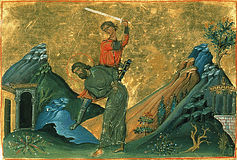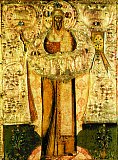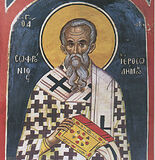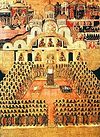

| Previous day | Next day |
| Old Style
March 11
|
Sunday |
New Style
March 24
|
|
First Sunday of Great Lent.
Tone 1.
Great Lent. |
Wine and oil allowed.
|
![]() St. Sophronius, patriarch of Jerusalem (638-644).
St. Sophronius, patriarch of Jerusalem (638-644). ![]() St. Euthymius, archbishop of Novgorod (1458).
St. Euthymius, archbishop of Novgorod (1458).
Hieromartyr Pionius, priest, of Smyrna, and those with him: Asclepiades, Macedonia, Linus, and Sabina (250). St. Sophronius, recluse of the Kiev Caves (13th c.). St. Sophronius, bishop of Vratsa (Bulgaria) (1813). Translation to Constantinople of the relics of Martyr Epimachus of Pelusium. St. Alexis of Goloseyevsky Skete, Kiev Caves (1917).
New Hiero-confessors Patrick (Petrov), hieromonk of Valaam Monastery (1933) and Michael (Galushko), schema-archimandrite, of Svyatogorsk Monastery (1961).
“Cyprus” Icon of the Most Holy Theotokos of Stromyn (Moscow).
St. George, abbot of Sinai (ca. 545), brother of St. John Climacus. St. Oengus (Angus) the Culdee, bishop, of Clonenagh (Ireland) (824). Hieromartyr Eulogius, metropolitan of Cordoba (859). St. George the New, wonderworker of Constantinople (ca. 970). St. Theodora, queen of Arta, wife of Despot Michael II of Epirus (ca. 1275). Hieromartyrs Trophimus and Thalus, priests, of Laodicea (300).
Slaying of Emperor Paul I of Russia (1801).
Thoughts for Each Day of the Year
According to the Daily Church Readings from the Word of God
By St. Theophan the Recluse

The First Sunday of Lent. [Heb. 11:24–26, 32–12:2; John 1:43–51]
The Sunday of Orthodoxy.[1] Do not forget the right word[2] which you spoke to God, renewing your testament with Him which you broke through your negligence. Remember how and why you broke it and try to avoid being unfaithful again. Pretty words are not glorious; faithfulness is glorious. Is it not glorious to have a testament with a king? How much more glorious is it to have a testament with the King of kings! But this glory becomes your disgrace if you are not faithful to this testament. How many great people have been glorified since the beginning of the world! And all of them have been glorified for their faithfulness, in which they stood firm, regardless of great misfortunes and sorrows as a result of this faithfulness. They had trial of cruel mockings and scourgings, yea, moreover of bonds and imprisonment: They were stoned, they were sawn asunder, were tempted, were slain with the sword: they wandered about in sheepskins and goatskins; being destitute, afflicted, tormented; Of whom the world was not worthy: they wandered in deserts, and in mountains, and in dens and caves of the earth…. Wherefore, seeing we are compassed about with so great a cloud of witnesses, let us run with patience the race that is set before us, looking unto Jesus the author and finisher of our faith (Heb. 11:36–38; 12:1–2).
[1] The first Sunday of Great Lent is called “The Sunday of Orthodoxy,” and celebrates the restoration of the veneration of Icons and the victory of Orthodoxy over the Iconoclast heresy.
[2] “The right word” is a reference to the meaning of the word “Orthodox” in Russian, which is literally “rightly glorifying.”
Articles
 Martyr Macedonia of SmyrnaSaint Macedonia was martyred during the persecution in the reign of Decius (249-251), along with Saints Pionius and Limnus, Sabina, and Asclepiades. |
 Martyr Limnus of SmyrnaSaint Limnus was martyred during the persecution in the reign of Decius (249-251), along with Saints Pionius and Macedonia, Sabina, and Asclepiades. |
 Venerable Sophronius the Recluse of the Kiev CavesSaint Sophronius the Hermit of the Caves was an ascetic of the Far Caves (the Theodosiev Caves), during the thirteenth century. |
 Translation of the relics of the Martyr Epimachus of PelusiumThe Holy Martyr Epimachus of Alexandria was a native of Egypt. |
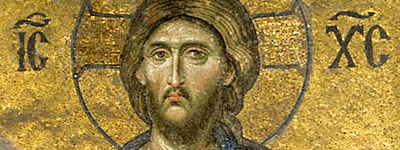 The Sunday of the Triumph of Orthodoxy |
 Triumph of Orthodoxy SundayFr. Thaddaeus HardenbrookAfter the exercise of Clean Week, the wisdom of the Church grants us a rest in the joy of Triumph of Orthodoxy Sunday. |
